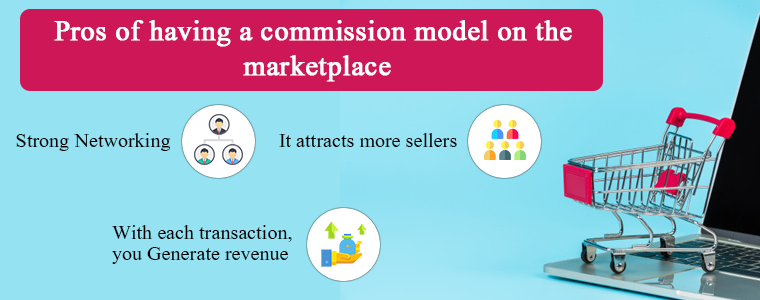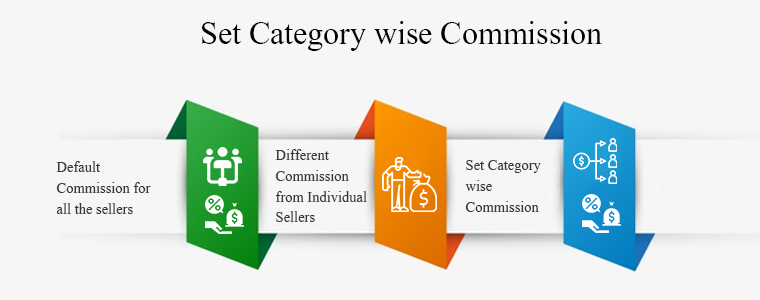There are various revenue models popular for the online marketplace and the most effective one is the Commission model. The online marketplaces are considered superior to classic eCommerce websites owned by the individual seller because the marketplaces are a major source of passive income. Marketplaces have a strong network which makes them more potent as it is difficult to compete with a network than to an eCommerce website.
The three basic techniques operated by the majority of the online marketplace for revenue generation are commission model, Membership plan, and listing fees. But there are currently several more revenue models on the market. Each one of them has its advantages and implementation difficulties.
The big marketplace businesses like Airbnb, Etsy, eBay, Fiverr, and Uber all rely on the commission revenue model. This is one of the most profitable business models because the owner generates a cookie on every product sold on the marketplace.
How does Commission Model operate?
For modern marketplaces, the most common business revenue model is the commission which involves charging a fee on each transaction. The platform manages the payment and charges either by percentage or a flat commission fee when a customer pays the vendor.
The greatest advantage of the commission revenue model is that the sellers do not have to pay anything until they complete their first order. This is genuinely appealing to the manufacturers. At the same time, the commission model is typically the most lucrative business model for the marketplace because you generate revenue on every sale.
Pros of having a commission model on the marketplace:

1. Strong networking
The commission-based business model has an advantage of strong networking because it has multiple sellers, several products, and a large customer base.
2. It attracts more sellers
It isn’t that simple to attract sellers in a new marketplace. But, an online marketplace is a channel for all the vendors who want to bring their brick and mortar to the online platform. They can sell their products on minimal commissions which can be easily covered in the profit margin.
3. With each transaction, you generate revenue
The admin can generate money on every transaction, be it a small or big purchase.
Biggest Challenge for Commission Business Model: Pricing
The commission model has a major challenge in pricing. How much commission to be charged? Whether it should be percentage based or fixed amount? Before deciding the commission you need to keep some points in mind. Firstly, See what your competitors are charging and make a pricing structure before implementing it. Secondly, consider the marginal cost. If a product has a large marginal range then the commission can be charged accordingly. Lastly, improve your commission model as per user requirements.

Fix the pricing challenge with Magento 2Marketplace Extension
The Magento 2 marketplace module can help you with questions like should the commission be the same for all consumers? Do I charge the supplier, the client, or both? What to do when people sell products from different categories and the profit margin varies to a large extent?
The commission on a Magento 2 Marketplace can be configured by the admin on three levels.
1. Default Commission for all the sellers
A global commission can be set for all the sellers who have registered on the Magento 2 Multi-Vendor marketplace platform. This commission will be applicable to every vendor.
2. Different Commission from Individual Sellers
Magento 2 Marketplace module allows the store owner to set a different commission percentage for individual sellers. Every seller on the marketplace can be charged uniquely and this can solve the pricing issue.
The priority is set to the seller-wise commission option that means the global commission will not be applicable if the admin assigns a different commission to the seller.
3. Set Category wise Commission
Different products have a different profit margin. For example, dairy products and essential food grains do not have high-profit margins. In this scenario, the Magento 2 Marketplace admin can set the commission based on category.
The Magento 2 Multi-vendor Marketplace by Knowband also supports the ‘Membership’business revenue model. It can be a great module for Magento 2 platform to start a marketplace effortlessly as it has several alluring features and benefits.
Final words:
Whenever possible, my advice is to use the commission model as the key revenue source. In the future, I expect more and more marketplaces to follow this revenue model. There are several other revenue models but the commission model is the most profitable one. You can use the Multi-vendor marketplace module for creating your marketplace and start earning with every product sold on your platform.
Commission model, Commission business model, commission revenue model, online marketplace, marketplace commission model, business revenue model,commission-based business model, Magento 2 Marketplace Extension, Magento 2 Marketplace
Related blogs:





